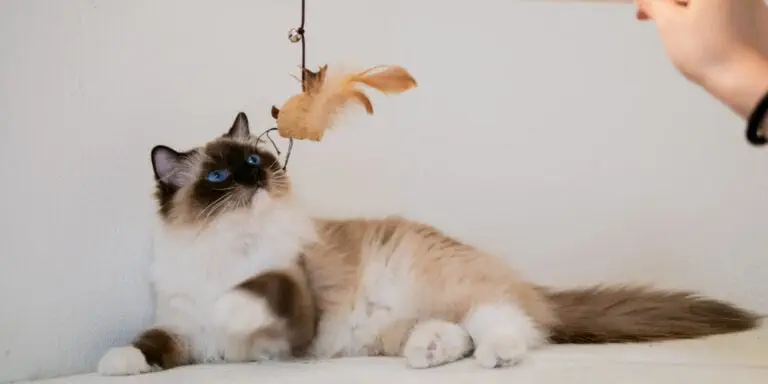The Best Fluffy Pancakes recipe you will fall in love with. Full of tips and tricks to help you make the best pancakes.

Do you love your ragdoll cat but hate the damage they can cause to your furniture? You’re not alone. Many cat owners struggle with their feline friends’ scratching habits, but it’s important to understand why they do it and how to prevent it.
Ragdolls, like all cats, have natural instincts to scratch. It helps them shed old layers of their claws, mark their territory, and stretch their muscles. However, if they don’t have appropriate outlets for their scratching needs, they may turn to your furniture as a substitute.
Don’t worry, though – there are ways to train your ragdoll and protect your furniture at the same time. With a little bit of understanding and effort, you can have a happy cat and a scratch-free home.
Why Cats Scratch
Do you know why cats scratch? It’s not because they’re trying to destroy your furniture or annoy you, but rather because it’s a natural behavior that’s essential for their health and well-being.
Scratching helps cats shed the outer layers of their claws, keeping them healthy and sharp for hunting and self-defense. Additionally, it’s a way for cats to mark their territory and communicate with other cats using their scent glands in their paws.
Understanding cat behavior and psychology is crucial in preventing destructive scratching behavior. Cats scratch for a variety of reasons, including stretching their muscles, relieving stress, and expressing their emotions.
It’s important to provide your cat with appropriate scratching surfaces, such as scratching posts or pads, and to discourage them from scratching furniture by using deterrents like double-sided tape or citrus sprays.
Scratching is a natural behavior for cats that serves many purposes, including keeping their claws healthy and sharp and marking their territory. By understanding your cat’s behavior and providing appropriate scratching surfaces, you can prevent destructive scratching and maintain a happy and healthy relationship with your feline friend.
Specific Scratching Habits of Ragdolls
You’ll find that your furry friend’s claws are like tiny sculpting tools, creating unique artwork on any surface they see fit. Unfortunately, this might include your furniture, carpets, and curtains.
Ragdolls, like any other breed of cat, have a natural instinct to scratch. This instinct serves multiple purposes, including sharpening their claws and marking their territory.
To prevent your ragdoll from scratching your furniture, it’s important to provide them with a designated scratching post. Ragdolls prefer tall posts that allow them to stretch and scratch at the same time. You can purchase a post or make one yourself using a sturdy material like sisal rope. Place the post in a central location in your home, so your ragdoll can access it easily.
Training techniques can also be used to teach your ragdoll to use the scratching post instead of your furniture. Positive reinforcement is key here. Reward your cat with treats and praise when they use the post, and gently redirect them when they start to scratch elsewhere. With time, patience, and consistency, your ragdoll will learn to use the post exclusively, saving your furniture from further damage.
Importance of Proper Training and Care
If you want to discourage your ragdoll from scratching furniture, proper training and care are essential.
One effective training tip is to provide an alternative scratching surface, such as a scratching post or pad.
You can also use positive reinforcement techniques, such as treats or praise, to encourage your cat to use the appropriate surface for scratching.
Make sure to give your furry friend plenty of attention and playtime as well, to prevent boredom and reduce the likelihood of destructive behavior. Remember, with patience and consistency, you can help your ragdoll become a well-behaved and happy member of your family.
Training Tips for Discouraging Scratching
To discourage scratching, try placing scratching posts in strategic locations around your home and rewarding your cat for using them. Here are some additional tips to help train your cat to use the scratching posts instead of your furniture:
- Consistency in training is key. Make sure everyone in your household is on board with the training plan and that your cat is consistently rewarded for using the scratching posts.
- Provide alternative behaviors for your cat to engage in, such as playing with toys or climbing on a designated cat tree. This will help redirect their attention away from your furniture.
- If you catch your cat scratching your furniture, gently redirect their attention to the scratching post and reward them for using it instead.
By following these tips and being patient with your cat, you can help discourage them from scratching your furniture and promote positive behaviors in your home. Remember, proper training and care can make all the difference in creating a happy and healthy environment for both you and your feline companion.
Providing Appropriate Scratching Surfaces
One way to make your home more cat-friendly is by having designated scratching surfaces that your feline friend will love to use. While it may be tempting to discourage your Ragdoll from scratching altogether, it’s important to understand that scratching is a natural behavior for cats. It provides them with a way to stretch their muscles, mark their territory, and sharpen their claws.
Instead of punishing your cat for scratching furniture, consider providing them with alternative scratching surfaces. Some great alternatives to traditional scratching posts include cardboard scratchers, sisal mats, and even tree stumps.
When choosing a scratching surface for your Ragdoll, it’s important to consider the material. While synthetic materials may be cheaper and more readily available, natural materials like sisal, jute, and seagrass are often preferred by cats. These materials provide a rough texture that helps to file down your cat’s claws, and they’re also biodegradable and environmentally friendly.
Additionally, natural materials may be more aesthetically pleasing in your home, and they can provide a more natural feel for your cat. By providing your Ragdoll with appropriate scratching surfaces, you can help to prevent damage to your furniture while also satisfying your cat’s natural instincts.
Understanding Your Cat’s Needs
Understanding your cat’s needs is crucial to ensuring they’re happy and healthy, and you’ll be amazed at how much joy you can bring into their lives with just a little effort.
When it comes to scratching, it’s important to understand that it’s a natural behavior for cats. Scratching helps cats mark their territory and keep their claws healthy. However, it can also be destructive to your furniture if they don’t have appropriate places to scratch.
Cat behavior plays a big role in whether or not they’ll scratch your furniture. Some cats are more prone to scratching furniture than others. Additionally, some cats may scratch out of boredom or stress. It’s important to provide plenty of appropriate scratching surfaces to help redirect their scratching behavior.
Scratch training is also key to ensuring your cat knows where they should be scratching. Providing scratching surfaces that meet your cat’s needs is important. Cats may prefer different types of surfaces, such as carpet, rope, or cardboard.
It’s also important to place scratching surfaces in strategic locations throughout your home. By understanding your cat’s needs and providing appropriate scratching surfaces, you can help prevent them from scratching your furniture and keep them healthy and happy.
Using Deterrents
You can keep your cat from damaging your home by using deterrents that are safe and effective. Scratching deterrents are a great way to prevent furniture damage. These products come in various forms, including sprays, tapes, and sticky pads.
Sprays are ideal for vertical surfaces, while tapes and sticky pads can be used on horizontal surfaces. Training techniques can also be used to help your cat understand where it is appropriate to scratch. Providing your cat with a designated scratching post can help redirect their scratching behavior.
You can also encourage your cat to use the post by using positive reinforcement, such as treats or praise. Consistency is key when it comes to training your cat, so be sure to reward them every time they use the scratching post.
It’s important to note that some cats may be more stubborn than others, and may require more training and deterrents to prevent furniture damage. If you’re having trouble with your cat scratching furniture, consider consulting with a veterinarian or animal behaviorist for additional guidance.
With patience and perseverance, you can train your cat to scratch in appropriate places and prevent damage to your home.
Positive Reinforcement
When it comes to training your ragdoll, positive reinforcement is one of the most effective methods. Rewards-based training involves giving your cat a treat or praise when they exhibit good behavior. For example, if your cat uses their scratching post instead of your furniture, you can give them a treat or praise them. This encourages good behavior through positive reinforcement and helps your ragdoll learn what is expected of them. It also reinforces positive habits.
Rewards-Based Training
Hey, wanna know a cool trick to keep your ragdoll from scratching up your furniture? Try rewards-based training! This technique involves using positive reinforcement to encourage good behavior and discourage bad behavior. By rewarding your cat for good behavior, you can train them to repeat that behavior and avoid scratching up your furniture.
Here are some tips for rewards-based training with your ragdoll:
- Use a clicker to mark good behavior: Clicker training is a form of positive reinforcement that involves using a clicker to mark the exact moment your cat does something good. This helps your cat associate the behavior with the reward they will receive.
- Use treats as rewards: When your cat does something good, reward them with a small treat. This will help them associate good behavior with positive outcomes.
- Consistency is key: Be consistent with your rewards-based training. If you reward your cat for good behavior one day and don’t reward them the next, they may become confused and revert back to bad behavior.
By using rewards-based training with your ragdoll, you can teach them to avoid scratching up your furniture and instead focus on good behavior. Remember to be patient and consistent, and soon your cat will be a well-behaved and happy member of your household.
Encouraging Good Behavior
Encouraging good behavior in your furry friend is essential for a harmonious household and a happy cat. One effective method for encouraging good behavior is through positive reinforcement. This means rewarding your cat for good behavior instead of punishing them for bad behavior. Rewards can include treats, toys, or even just verbal praise.
By rewarding your cat for good behavior, they’ll be more likely to continue that behavior in the future. Redirecting behavior is another effective method for encouraging good behavior in your cat. This means redirecting their attention to a more appropriate activity when they’re engaging in unwanted behavior, such as scratching furniture.
For example, if your cat starts scratching the couch, redirect their attention to a scratching post or a toy. This will not only prevent them from damaging your furniture, but also encourage them to engage in more appropriate behavior. Remember to always be patient and consistent when encouraging good behavior in your furry friend.
With time and effort, you can create a harmonious household where both you and your cat can thrive.
Protecting Your Furniture
To prevent your furniture from getting scratched by your ragdoll, you should consider using scratch-proof covers or providing a designated scratching post. Furniture covers are a great way to protect your furniture from scratches and other forms of damage caused by your furry friend. These covers come in various sizes, colors, and materials, making it easy for you to find one that suits your needs.
Another option is to provide your ragdoll with a designated scratching post. This will give your pet a safe and appropriate place to scratch without damaging your furniture. There are many different types of scratching posts available, such as vertical, horizontal, and angled posts. You can also find scratching posts made from various materials, including sisal, carpet, and cardboard.
Here are some tips to help you choose the right scratching post for your ragdoll:
- Make sure the post is tall enough for your cat to fully stretch out and scratch.
- Choose a post made from a sturdy material that will hold up to your cat’s scratching.
- Place the post in an area where your cat spends a lot of time, such as near their favorite sleeping spot.
- Encourage your cat to use the post by rewarding them with treats and praise when they scratch it instead of your furniture.
By following these tips and providing your ragdoll with a designated scratching post or using scratch-proof covers, you can protect your furniture and keep your furry friend happy and healthy. Remember, a well-cared-for ragdoll is a happy ragdoll.
Do Ragdolls Scratch Furniture When Left Alone?
Yes, leaving Ragdolls alone may result in furniture scratches. These sociable cats can get anxious when left alone, leading to destructive behavior like scratching furniture. Providing them with scratching posts and interactive toys can help redirect their energy and prevent damage to your furniture.
Conclusion
Congratulations! You’re now an expert on ragdoll cats and their scratching habits. You know that they scratch for a variety of reasons, including marking their territory and stretching their muscles.
You also know that proper training and care are essential to preventing them from scratching your furniture. But let’s be real here, you’re not going to stop your ragdoll from scratching altogether. They’re cats, after all.
So, what can you do to protect your precious furniture? Well, you can try using deterrents like double-sided tape or aluminum foil. Or, you can use positive reinforcement to encourage your cat to scratch on appropriate surfaces like scratching posts.
In the end, it’s all about understanding your cat’s needs and finding a solution that works for both of you. So, go forth and enjoy your ragdoll cat without fear of furniture destruction.
And if all else fails, just remember that a few scratches here and there add character to your home decor. Who needs a pristine couch anyway?








